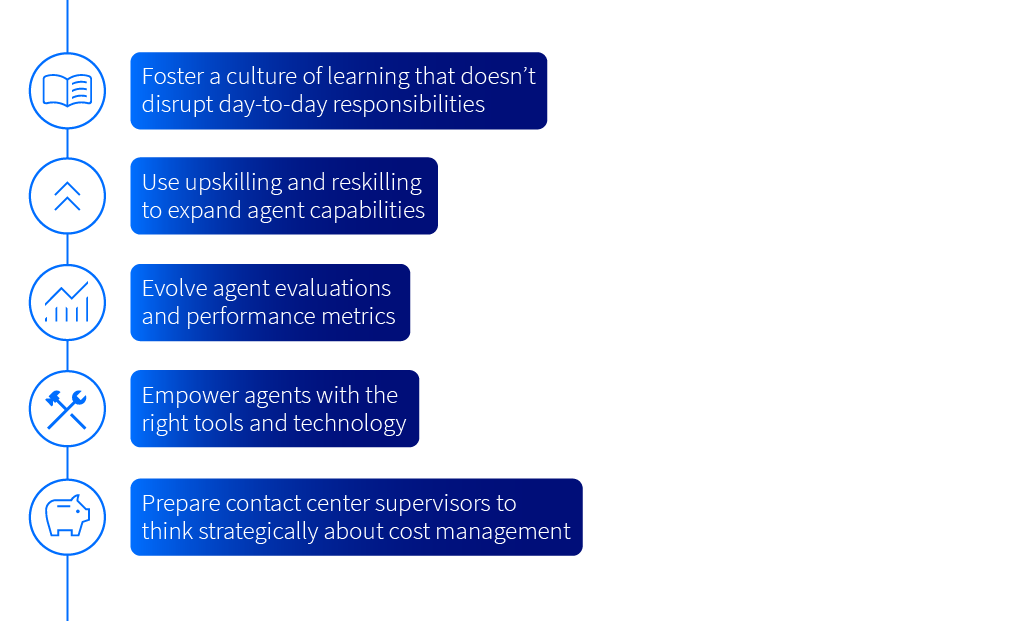These days, every contact center seems to be experiencing higher-than-usual call volumes. With 57% of leaders expecting call volumes to increase over the next 12 or 24 months, it’s hard to imagine contact centers being anything more than what they’ve always been: reactive cost centers doing all they can to tread water.

At the same time, many contact center leaders are looking for ways to shake up the norm—to find opportunities for revenue generation within the existing contact center model. It’s feasible and doesn’t necessarily require call center agents to double as salespeople, nor does it require a complete upheaval of existing infrastructure.
What it does require, in a lot of cases, is a reframing of the contact center model, alongside investment in better customer experiences that improve relations and promote customer longevity. In other words, a more proactive contact center strategy.
The formula for revenue generation in the contact center
When we say generate revenue, we don’t mean turn your support agents into sales reps. Instead, we mean making the investment in areas that elevate service quality, of which customer loyalty, reduced churn, and sustainable growth are direct byproducts.
Proactive, personalized customer service can turn simple renewals into account expansions. It can turn bad experiences into great ones that earn the long-term business of discerning customers. As the old saying goes, acquiring new customers is ten times more expensive than keeping the ones you have. Superb customer service is one of the best ways to do the latter.
Salesforce lays 3 Steps to Increase your Contact Center Revenue in a simple but effective formula:

Empower agents to reduce handling time
At its core, the contact center is there to help customers, a responsibility that will likely never change. How agents help customers and how effectively can always be improved. Shave enough seconds or minutes off of average handle time, for starters, and your team can significantly reduce base cost to support.
In What the Future of Work Means for Agents in the Contact Center, you’ll find five practical strategies for cultivating productive agents in the new contact center paradigm:

Invest in and expand self-service
The numbers don’t lie: 88% of customer journeys start with self-service. What’s more, those journeys tend to involve multiple channels en route to a solution. Beyond its potential for cost-saving case deflection, self-service supports revenue generation in a few key ways:
- Gather valuable customer data at every touchpoint
- Personalize service experiences that engender loyalty
- Uncover opportunities for proactive product/service recommendations
Webex, Bucher + Suter’s preferred cloud contact center solution, helped First Horizon Bank expand self-service for its 1.1 million customers. Their implementation of Webex Contact Center allowed for the onboarding of 1500 agents while ensuring highly personalized self-service experiences at every turn. Since the implementation, First Horizon has seen its monthly self-service rate jump to 87%.
Enrich the post-purchase experience
Many customers evaluate brands based on service experiences, often before they even make a purchase. We know, for example, that 90% of consumers consider customer service to be an essential factor in their purchasing decisions. And 88% of customers are more likely to purchase from companies that meet their service expectations again.

As the frontline and mouthpiece for so many customer interactions, service agents are in a terrific position to provide exceptional post-purchase experiences. Just knowing who a customer is, their history with the company, and where they’re at in a given journey can differentiate a service experience considerably.
Start small and build toward a more proactive contact center
In customer service, context is everything. Orchestrating personalized and proactive journeys will look slightly different in financial services, for example, or healthcare. Instead of trying to understand a massive change to your tech stack—implementing sales engagement and enablement tools, for example—do more with what you have.
For example, you can use call analytics and speech recognition to identify sales cues in customer interactions. From there, AI can automatically suggest relevant upsell or cross-sell opportunities to agents, removing much of the legwork that a trained salesperson might otherwise expect.
In addition, look for ways to enhance the backbones of your existing infrastructure: CRM, contact center platform, and integrations. Together with Webex Connect, for instance, you can send proactive follow-ups to customers based on their recent interactions:
“Berta, thanks for chatting with us earlier this week. As thanks for your continued collaboration on those issues you had, we want to offer you a free one-month extension to your contract.”
Cloud contact center solutions like Webex Contact Center also have a significant role to play. A cloud solution that scales to meet demand and has intelligent cost-saving features like Intelligent Virtual Agents (IVA) can help support many aspects of the post-sale service experience.

Of the contact centers that today offer multiple service channels, only 7% have the means to transition customers between them seamlessly—that is, moving not only customers from channel to channel but also their data, history, and context. A little more than one in two leaders say they’ve implemented some form of “right-channeling” to guide customers to the best channel (Deloitte). Omnichannel routing is a foundational part of proactive customer service. You’ll find it in most revenue-generating contact centers.
Reactive support has its cost
For contact center leaders focused on generating revenue, the opportunities have never been more numerous. Some even train their service agents in the fine art of cross-selling and upselling, a strategy replete with on-call scripts and sales-oriented performance metrics. In the past, Google has even made recommendations for finding synergies between the contact center and marketing.
In the end, building a proactive, revenue-forward contact center is less about outright selling than it is about cultivating positive customer experiences that promote higher customer lifetime value. When customers purchase again because they feel their needs have been anticipated and met, that’s revenue. When a customer acts on personalized recommendations that make their ownership experience—and their lives—more straightforward, that’s revenue.
On the flip side, when a customer has a bad experience and decides to leave, that’s a lost opportunity for revenue. In an environment where 32% of customers do so after just one bad experience, the time to shift from reactive to proactive is now.





